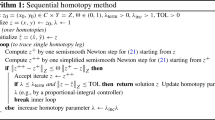Abstract
In this note, we consider the solution of a linear program, using suitably adapted homotopy techniques of nonlinear programming and equation solving that move through the interior of the polytope of feasible solutions. The homotopy is defined by means of a quadratic regularizing term in an appropriate metric. We also briefly discuss algorithmic implications and connections with the affine variant of Karmarkar's method.
Similar content being viewed by others
References
G. B. Dantzig,Linear Programming and Extensions, Princeton University Press, Princeton, NJ, 1963.
B. C. Eaves, A view of complementary pivot theory (or solving equations with homotopies), inConstructive Approaches to Mathematical Models (C. V. Coffman and G. J. Fix, eds.), Academic Press, New York, 1979, pp. 153–170.
B. C. Eaves and H. Scarf, The solution of systems of piecewise-linear equations,Math. Oper. Res.,1 (1976), 1–27.
C. B. Garcia and W. I. Zangwill,Pathways to Solutions, Fixed Points and Equilibria, Prentice-Hall, Englewood Cliffs, NJ, 1981.
P. E. Gill, W. Murray, M. A. Saunders, J. A. Tomlin, and M. H. Wright, On projected Newton barrier methods for linear programming and an equivalence to Karmarkar's projective method, Technical Report SOL 85-11, Systems Optimization Laboratory, Department of Operations Research, Stanford University, Stanford, CA, 1985.
M. Hirsch and S. Smale, On algorithms for solvingf(x) = 0,Comm. Pure Appl. Math.,32 (1979), 281–312.
N. Karmarkar, A new polynomial-time algorithm for linear programming,Proceedings of the 16th Annual ACM Symposium on Theory of Computing, 1984, pp. 302–311.
L. G. Khachiyan, A polynomial algorithm for linear programming,Dokl. Akad. Nauk SSSR,244 (1979), 1093–1096 (translated inSoviet Math. Dokl,20 (1979), 191–194).
C. E. Lemke, On complementary pivot theory, inMathematics of the Decision Sciences (G. B. Dantzig and A. F. Veinott, eds.), American Mathematical Society, Providence, RI, 1968.
O. L. Mangasarian, Iterative solution of linear programs,SIAM J. Numer. Anal,18 (1981), 606–614.
N. Megiddo, A variation on Karmarkar's algorithm, Preliminary Report, IBM Research Laboratory, San Jose, CA, 1985.
B. N. Pschenichny and Y. M. Danilin,Numerical Methods in Extremum Problems, M.I.R., Moscow, 1975 (English translation, 1978).
R. T. Rockafellar, Augmented lagrangians and applications of the proximal point algorithm in convex programming,Math. Oper. Res.,1 (1976), 97–116.
D. F. Shanno, A reduced gradient variant of Karmarkar's algorithm, Working Paper 85-01, Graduate School of Administration, University of California, Davis, CA, 1985.
N. Z. Shor, Generalized gradient methods of non-differentiable optimization employing space dilation operations, inMathematical Programming: The State of the Art (A. Bachem, M. Grotschel, and B. Korte, eds.), Springer-Verlag, Berlin, 1983, pp. 501–529.
S. Smale, A convergent process of price adjustment and global Newton methods,J. Math. Econom.,3 (1976), 107–120.
S. Smale, The problem of the average speed of the simplex method, inMathematical Programming: The State of the Art (A. Bachem, M. Grotschel, and B. Korte, eds.), Springer-Verlag, Berlin, 1983, pp. 530–539.
G. Strang, Karmarkar's algorithm in a nutshell,SIAM News,18 (1985), 13.
M. J. Todd and B. P. Burrell, An extension of Karmarkar's algorithm for linear programming using dual variables, Technical Report 648, School of Operations Research and Industrial Engineering, Cornell University, Ithaca, NY, 1985.
J. A. Tomlin, An experimental approach to Karmarkar's linear programming algorithm, Preprint, Ketron Inc., Mountain View, CA, 1985.
Author information
Authors and Affiliations
Additional information
Communicated by Nimrod Megiddo.
This is a revised version of a paper previously entitled “Karmarkar's Method and Homotopies with Restarts”.
Rights and permissions
About this article
Cite this article
Nazareth, J.L. Homotopy techniques in linear programming. Algorithmica 1, 529–535 (1986). https://doi.org/10.1007/BF01840461
Received:
Revised:
Issue Date:
DOI: https://doi.org/10.1007/BF01840461




